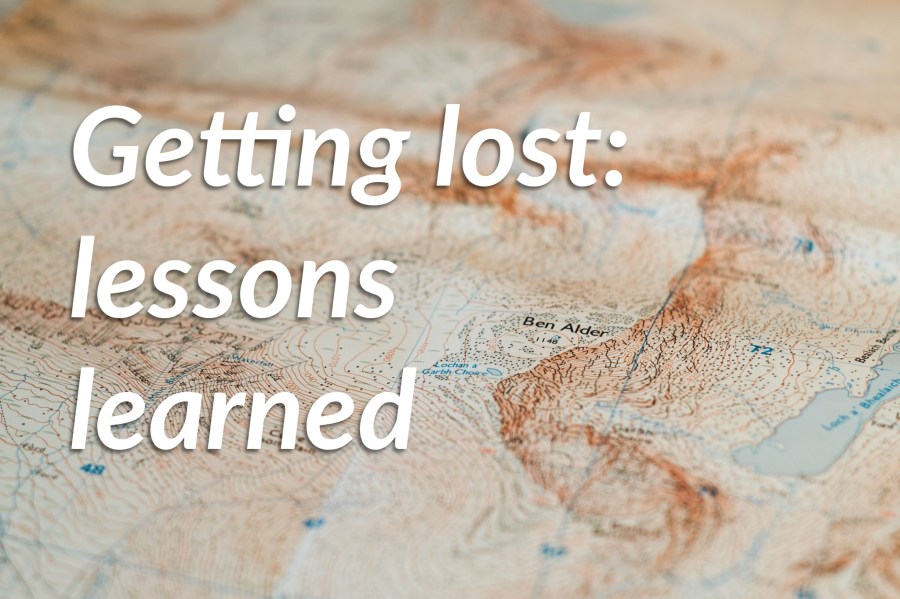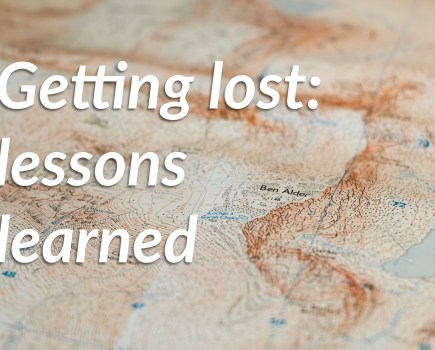“I learned on that trip to get more in touch with my capabilities and thereby avoid getting into ‘situations’ in the first place.”
This is part of our series of reader submissions on getting lost and lessons learned the hard way. To read more entries, and to find out how to submit your own, see this page.
Matthew King is a long-distance walker, hiker, and artist. He blogs at backpackartist.com and matthewkingarts.com.
An extended version of this story was originally published on mountainsafety.co.uk.
I sat on a rock and cried for my mummy. The rain was sheeting down, visibility was zilch and I couldn’t be entirely sure where I was. Sensibly, I stayed perched on the rock for a few minutes whilst I recovered some composure. Even in my befuddled and bedraggled state I knew that panic wouldn’t get me anywhere, and I also sensed that this was a decisive moment for my nascent walking career.
This was supposed to be a relatively straightforward walk from one valley to another on a well-defined route. But the rain had started soon after I staggered under the weight of my stupidly heavy pack from Stonethwaite up to Greenup Gill. The rain wasn’t too bad in itself but got decidedly worse when the cloud base was reached and visibility plummeted. But even this shouldn’t have presented a major problem if I’d simply crossed the depression between Ullscarf and High Raise and headed straight down into the valley the other side.
But no, I had to attempt to summit Ullscarf as I was passing. And here the day started to go wrong, setting off a chain reaction of misery.
Visibility was so poor that thigh-high rocks assumed the stature of major outcrops due to the foreshortening effect of the mist, luring me into thinking I was close to the summit, and persuading me to push on that little bit further.
At no stage did my compass leave my rucksack and my route was all over the place. Eventually, with no sign of the summit, sense prevailed and I turned around to attempt to find the way back down. I soon came upon the line of ruined fence posts that is the only real navigational aid on that fellside, and these helped me get back to the col.
“I waded around in circles a few times and then stood still in the swirling ooze to think and to attempt to work things out”
Now just the theoretically simple matter of dropping down into Far Easedale. Again no apparent path and I ended up heading for the lowest looking point in the east and hoping that this would funnel me into Flour Gill. It did, but now the horror cranked up a notch. As I dropped lower, the rain became harder and simply finding and keeping the path became a major problem. The gradient flattened out and all there was in front of me was bog.
I slipped and slid several times, and then I was in the midst of the bog with no path. I waded around in circles a few times and then stood still in the swirling ooze to think and to attempt to work things out using my (fortunately) waterproof map. I could vaguely see the line of a beck on the right. Keeping the stream on my right I waded through the bog and 30 seconds later found a suggestion of a path – and some ground falling away in front of me. The way down.
I staggered onto the path and soon spied a convenient rock. I squelched over to the rock, hugged it for several seconds and then sat on it, while I let it all out.
Of course, I couldn’t stay there forever. It was still tipping down and after a while I was starting to feel a bit cold. So I got moving again, but took it slow and steady and focused totally on each step and a mantra of “one step at a time”.
Three hours after heading down into Flour Gill, I limped into Grasmere and collapsed in the bus shelter until the bus came to whisk me to the safe haven of Ambleside.
So goes the tale of what was probably my worst ever day hillwalking – a day when the weather really had it in for me, and I found myself alarmingly close to my limits. The lessons learned that day, and on the rest of the trip leading up to it, have stayed with me ever since.
On Reflection…
I learned on that trip to get more in touch with my capabilities and thereby avoid getting into ‘situations’ in the first place. For me this means things like being sensible with the load I’m carrying and adapting the walk to reflect it; how to read the weather forecast so I can judge whether it is likely to be a problem; and measuring my progress on a walk so I know when to call it a day.
Secondly, when I plan a walk now I actively consider possible escape routes in case the walk might have to be cut short, and am much more aware of those parts of a route which are likely to have less people on them, and therefore more problematic for me as a solo walker if I were to hurt myself.
“judgement is really at the root of all of the lessons I’ve learned on the hill”
I did buy a GPS soon after that walk, but it really is no substitute for being able to read a map and use a compass. My compass would have got me out of trouble faster that day, and doesn’t sit in my rucksack any more: now it lives in a shirt pocket, even though I tend to only use it when the visibility is reduced or the terrain is confusing. Not bothering to look at a compass once saw me descend into the wrong valley.
The thing that has had the biggest impact on my safety and confidence in the hills, however, is my sports watch. I always work out my route using digital mapping beforehand so know the distance, amount of ascent and a reasonably good estimate of how long it will take. The watch tracks the distance covered, tells me what height I’m at and how much I’ve climbed or descended. All of this information allows me to keep a constant check on how far still to go, how long it will take etc. Several times, just knowing these things and being able to calculate the rest of the walk has ensured I’ve caught the last bus home, or has enabled me to make a judgement call to cut the walk short. It’s not an expensive watch – it cost £100 from Decathlon – but it’s repaid the cost many times over in the security it’s brought to my walks and the ability to make sound judgements on the hoof.
And judgement is really at the root of all of the lessons I’ve learned on the hill. Judging when to walk and when to have a day in the pub; judging an appropriate distance and terrain for a walk; knowing when to call it a day whilst out on a walk; making good decisions about what to carry; buying the gear I need for how I walk rather than just what everyone else does; and understanding that staying calm and trying to think clearly is the best way to dig yourself out of trouble.
Read more in our reader series ‘Getting lost: lessons learned the hard way’






